Alfa Romeo Giulietta 2013 Owner handbook (in English)
Manufacturer: ALFA ROMEO, Model Year: 2013, Model line: Giulietta, Model: Alfa Romeo Giulietta 2013Pages: 292, PDF Size: 13.06 MB
Page 91 of 292
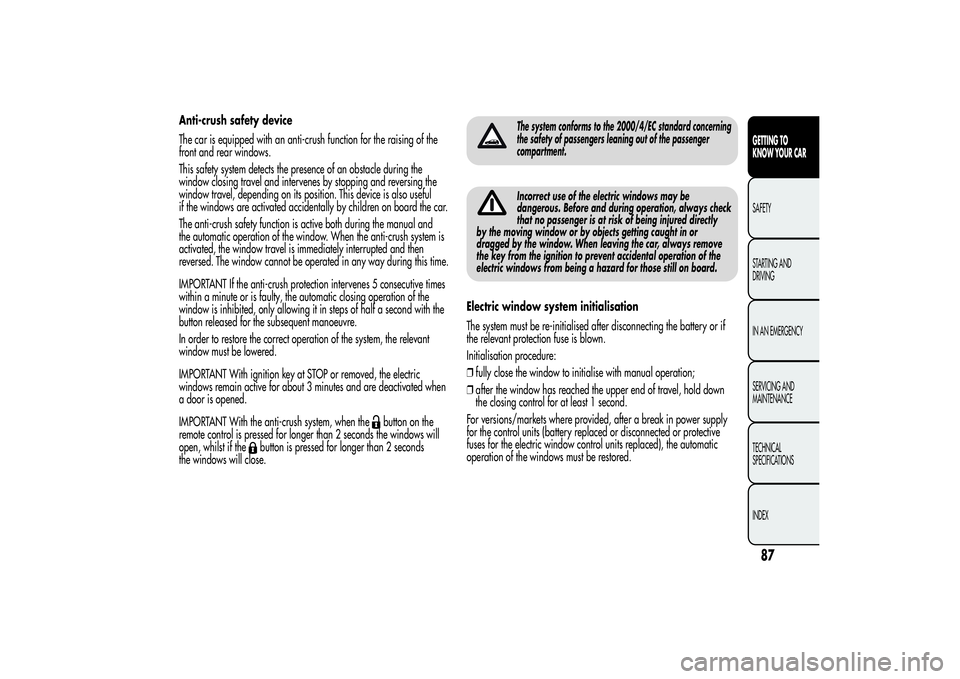
Anti-crush safety device
The car is equipped with an anti-crush function for the raising of the
front and rear windows.
This safety system detects the presence of an obstacle during the
window closing travel and intervenes by stopping and reversing the
window travel, depending on its position. This device is also useful
if the windows are activated accidentally by children on board the car.
The anti-crush safety function is active both during the manual and
the automatic operation of the window. When the anti-crush system is
activated, the window travel is immediately interrupted and then
reversed. The window cannot be operated in any way during this time.
IMPORTANT If the anti-crush protection intervenes 5 consecutive times
within a minute or is faulty, the automatic closing operation of the
window is inhibited, only allowing it in steps of half a second with the
button released for the subsequent manoeuvre.
In order to restore the correct operation of the system, the relevant
window must be lowered.
IMPORTANT With ignition key at STOP or removed, the electric
windows remain active for about 3 minutes and are deactivated when
a door is opened.
IMPORTANT With the anti-crush system, when the
button on the
remote control is pressed for longer than 2 seconds the windows will
open, whilst if the
button is pressed for longer than 2 seconds
the windows will close.
The system conforms to the 2000/4/EC standard concerning
the safety of passengers leaning out of the passenger
compartment.Incorrect use of the electric windows may be
dangerous. Before and during operation, always check
that no passenger is at risk of being injured directly
by the moving window or by objects getting caught in or
dragged by the window. When leaving the car, always remove
the key from the ignition to prevent accidental operation of the
electric windows from being a hazard for those still on board.
Electric window system initialisation
The system must be re-initialised after disconnecting the battery or if
the relevant protection fuse is blown.
Initialisation procedure:
❒fully close the window to initialise with manual operation;
❒after the window has reached the upper end of travel, hold down
the closing control for at least 1 second.
For versions/markets where provided, after a break in power supply
for the control units (battery replaced or disconnected or protective
fuses for the electric window control units replaced), the automatic
operation of the windows must be restored.
87GETTING TO
KNOW YOUR CARSAFETY
STARTING AND
DRIVING
IN AN EMERGENCY
SERVICING AND
MAINTENANCE
TECHNICAL
SPECIFICATIONS
INDEX
Page 92 of 292
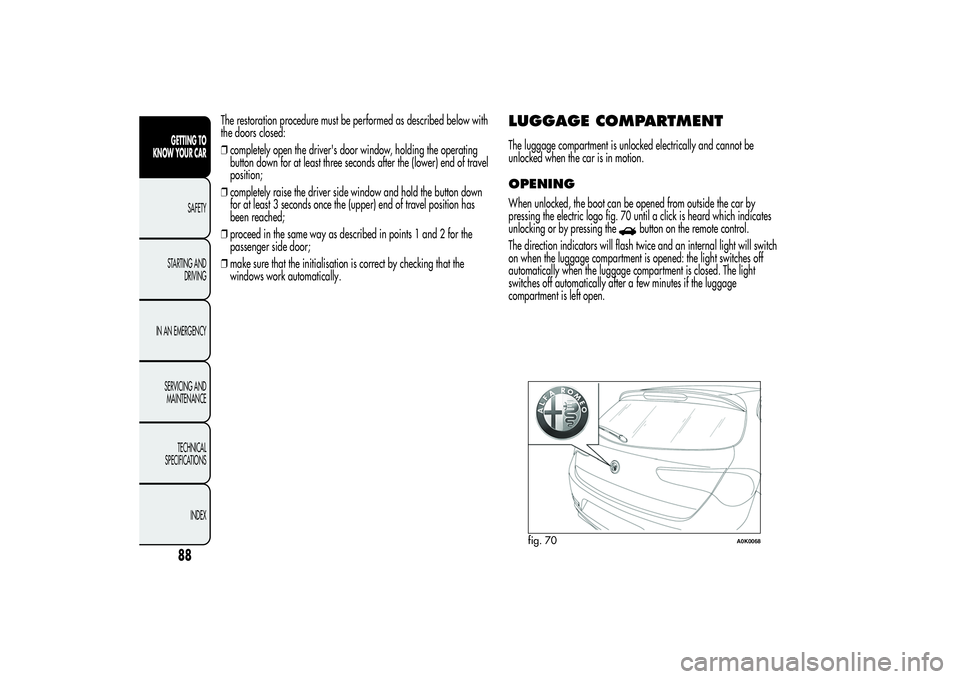
The restoration procedure must be performed as described below with
the doors closed:
❒completely open the driver's door window, holding the operating
button down for at least three seconds after the (lower) end of travel
position;
❒completely raise the driver side window and hold the button down
for at least 3 seconds once the (upper) end of travel position has
been reached;
❒proceed in the same way as described in points 1 and 2 for the
passenger side door;
❒make sure that the initialisation is correct by checking that the
windows work automatically.
LUGGAGE COMPARTMENTThe luggage compartment is unlocked electrically and cannot be
unlocked when the car is in motion.OPENINGWhen unlocked, the boot can be opened from outside the car by
pressing the electric logo fig. 70 until a click is heard which indicates
unlocking or by pressing the
button on the remote control.
The direction indicators will flash twice and an internal light will switch
on when the luggage compartment is opened: the light switches off
automatically when the luggage compartment is closed. The light
switches off automatically after a few minutes if the luggage
compartment is left open.
fig. 70
A0K0068
88GETTING TO
KNOW YOUR CAR
SAFETY
STARTING AND
DRIVING
IN AN EMERGENCY
SERVICING AND
MAINTENANCE
TECHNICAL
SPECIFICATIONS
INDEX
Page 93 of 292
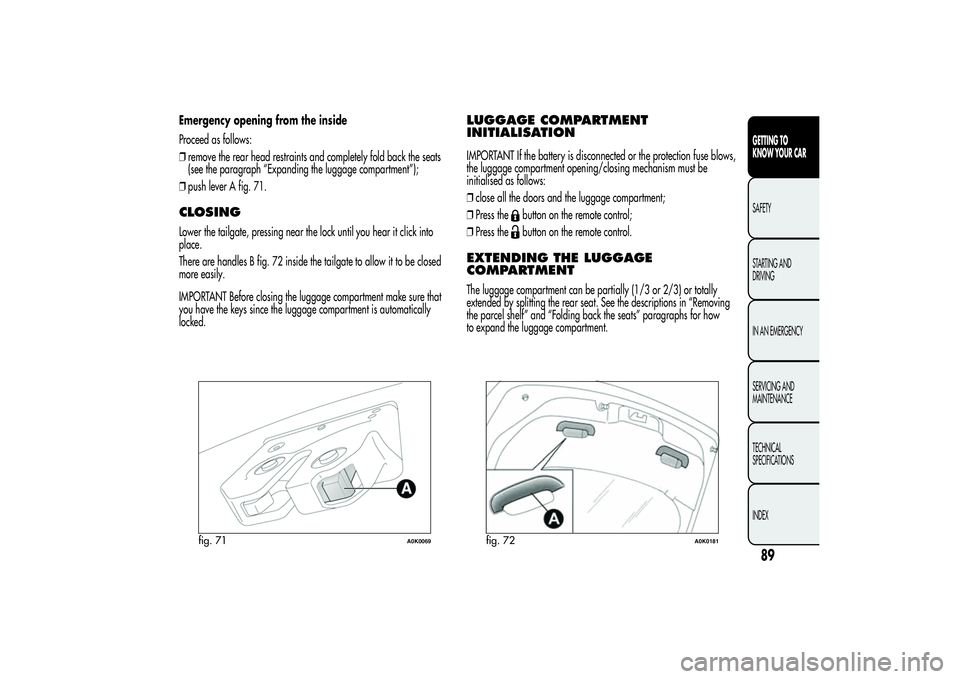
Emergency opening from the inside
Proceed as follows:
❒remove the rear head restraints and completely fold back the seats
(see the paragraph “Expanding the luggage compartment”);
❒push lever A fig. 71.CLOSINGLower the tailgate, pressing near the lock until you hear it click into
place.
There are handles B fig. 72 inside the tailgate to allow it to be closed
more easily.
IMPORTANT Before closing the luggage compartment make sure that
you have the keys since the luggage compartment is automatically
locked.
LUGGAGE COMPARTMENT
INITIALISATIONIMPORTANT If the battery is disconnected or the protection fuse blows,
the luggage compartment opening/closing mechanism must be
initialised as follows:
❒close all the doors and the luggage compartment;
❒Press the
button on the remote control;
❒Press thebutton on the remote control.
EXTENDING THE LUGGAGE
COMPARTMENTThe luggage compartment can be partially (1/3 or 2/3) or totally
extended by splitting the rear seat. See the descriptions in “Removing
the parcel shelf” and “Folding back the seats” paragraphs for how
to expand the luggage compartment.
fig. 71
A0K0069
fig. 72
A0K0181
89GETTING TO
KNOW YOUR CARSAFETY
STARTING AND
DRIVING
IN AN EMERGENCY
SERVICING AND
MAINTENANCE
TECHNICAL
SPECIFICATIONS
INDEX
Page 94 of 292
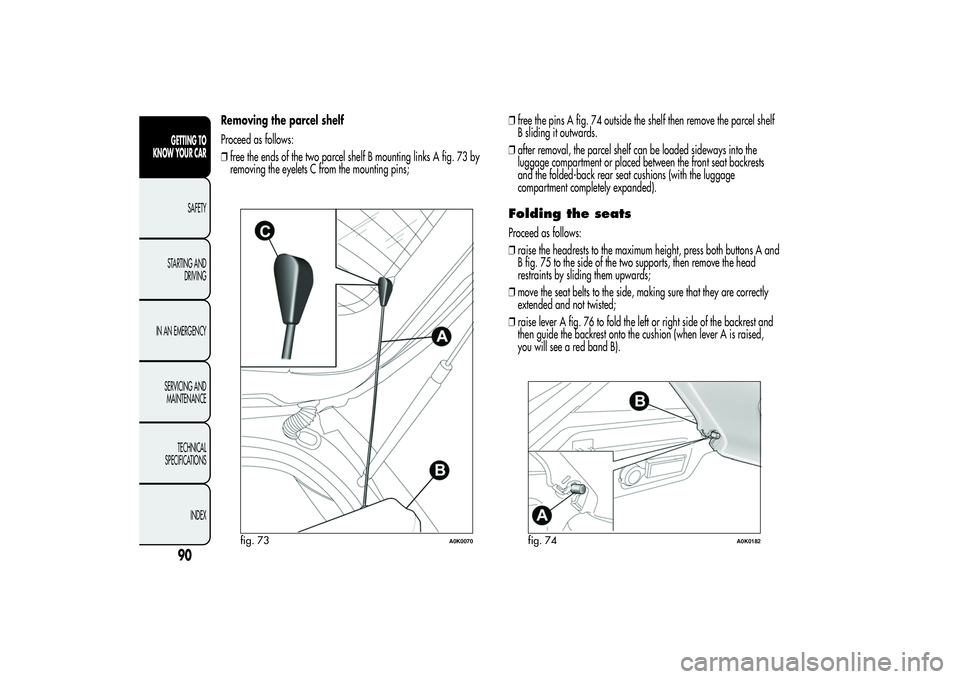
Removing the parcel shelf
Proceed as follows:
❒free the ends of the two parcel shelf B mounting links A fig. 73 by
removing the eyelets C from the mounting pins;❒free the pins A fig. 74 outside the shelf then remove the parcel shelf
B sliding it outwards.
❒after removal, the parcel shelf can be loaded sideways into the
luggage compartment or placed between the front seat backrests
and the folded-back rear seat cushions (with the luggage
compartment completely expanded).
Folding the seatsProceed as follows:
❒raise the headrests to the maximum height, press both buttons A and
B fig. 75 to the side of the two supports, then remove the head
restraints by sliding them upwards;
❒move the seat belts to the side, making sure that they are correctly
extended and not twisted;
❒raise lever A fig. 76 to fold the left or right side of the backrest and
then guide the backrest onto the cushion (when lever A is raised,
you will see a red band B).
fig. 73
A0K0070
fig. 74
A0K0182
90GETTING TO
KNOW YOUR CAR
SAFETY
STARTING AND
DRIVING
IN AN EMERGENCY
SERVICING AND
MAINTENANCE
TECHNICAL
SPECIFICATIONS
INDEX
Page 95 of 292
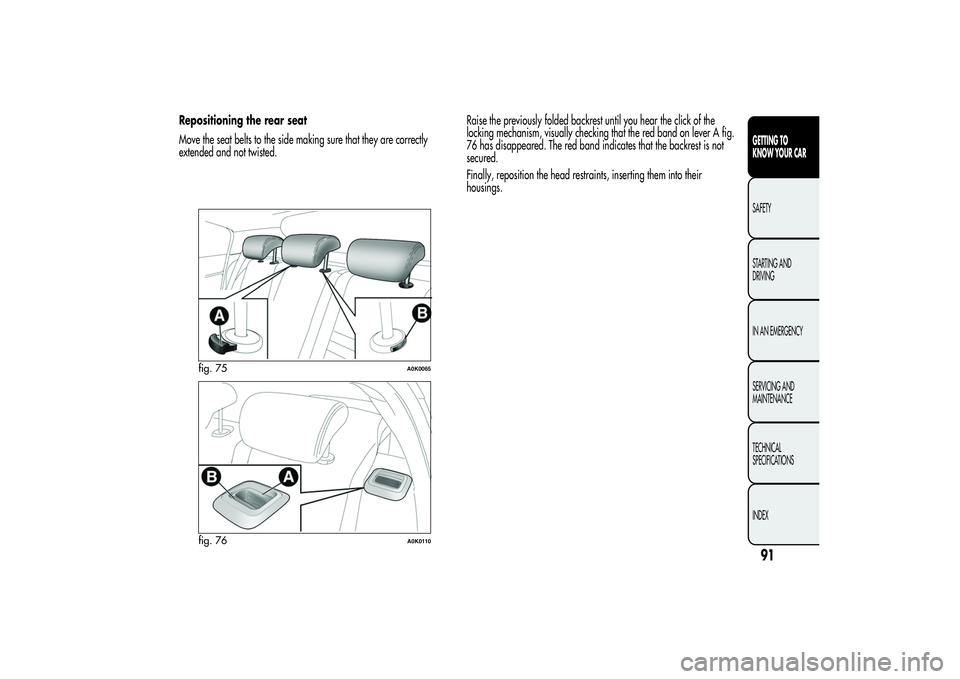
Repositioning the rear seat
Move the seat belts to the side making sure that they are correctly
extended and not twisted.Raise the previously folded backrest until you hear the click of the
locking mechanism, visually checking that the red band on lever A fig.
76 has disappeared. The red band indicates that the backrest is not
secured.
Finally, reposition the head restraints, inserting them into their
housings.
fig. 75
A0K0065
fig. 76
A0K0110
91GETTING TO
KNOW YOUR CARSAFETY
STARTING AND
DRIVING
IN AN EMERGENCY
SERVICING AND
MAINTENANCE
TECHNICAL
SPECIFICATIONS
INDEX
Page 96 of 292
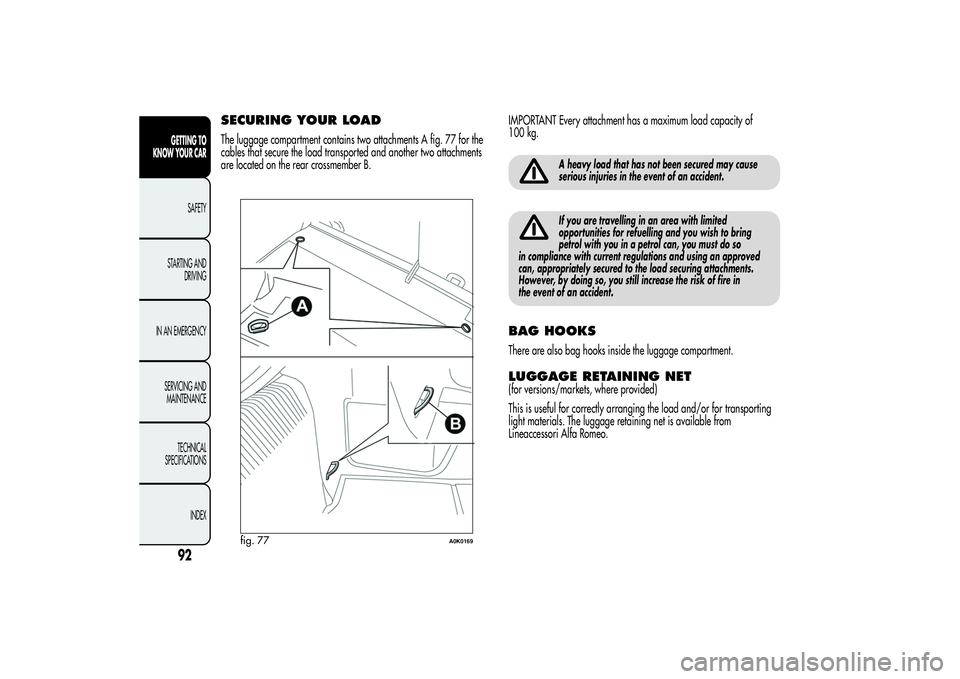
SECURING YOUR LOADThe luggage compartment contains two attachments A fig. 77 for the
cables that secure the load transported and another two attachments
are located on the rear crossmember B.IMPORTANT Every attachment has a maximum load capacity of
100 kg.
A heavy load that has not been secured may cause
serious injuries in the event of an accident.If you are travelling in an area with limited
opportunities for refuelling and you wish to bring
petrol with you in a petrol can, you must do so
in compliance with current regulations and using an approved
can, appropriately secured to the load securing attachments.
However, by doing so, you still increase the risk of fire in
the event of an accident.
BAG HOOKSThere are also bag hooks inside the luggage compartment.LUGGAGE RETAINING NET(for versions/markets, where provided)
This is useful for correctly arranging the load and/or for transporting
light materials. The luggage retaining net is available from
Lineaccessori Alfa Romeo.
fig. 77
A0K0169
92GETTING TO
KNOW YOUR CAR
SAFETY
STARTING AND
DRIVING
IN AN EMERGENCY
SERVICING AND
MAINTENANCE
TECHNICAL
SPECIFICATIONS
INDEX
Page 97 of 292
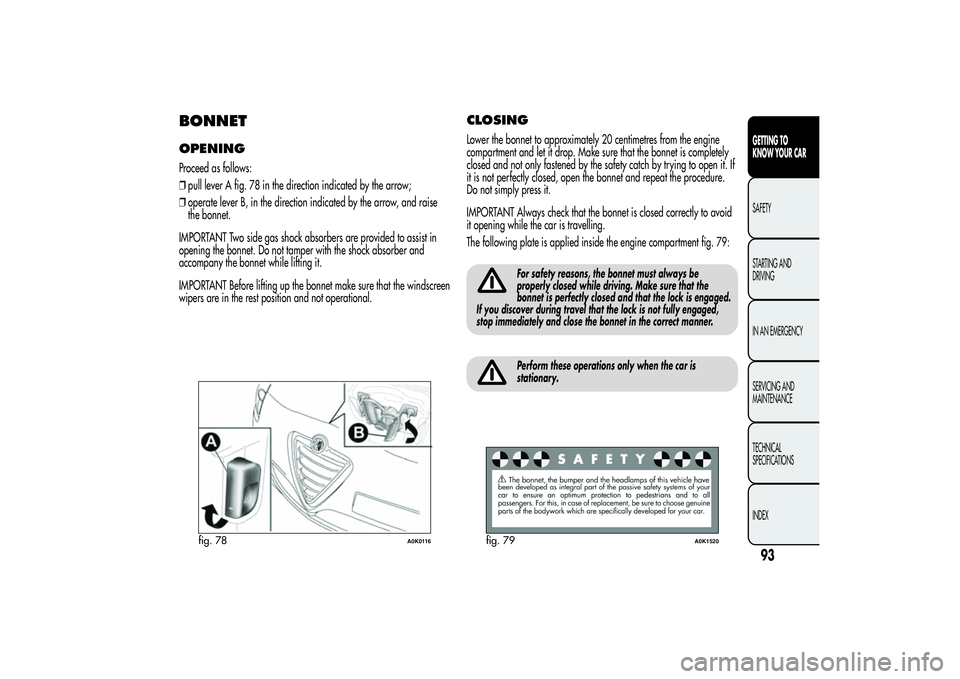
BONNETOPENINGProceed as follows:
❒pull lever A fig. 78 in the direction indicated by the arrow;
❒operate lever B, in the direction indicated by the arrow, and raise
the bonnet.
IMPORTANT Two side gas shock absorbers are provided to assist in
opening the bonnet. Do not tamper with the shock absorber and
accompany the bonnet while lifting it.
IMPORTANT Before lifting up the bonnet make sure that the windscreen
wipers are in the rest position and not operational.
CLOSINGLower the bonnet to approximately 20 centimetres from the engine
compartment and let it drop. Make sure that the bonnet is completely
closed and not only fastened by the safety catch by trying to open it. If
it is not perfectly closed, open the bonnet and repeat the procedure.
Do not simply press it.
IMPORTANT Always check that the bonnet is closed correctly to avoid
it opening while the car is travelling.
The following plate is applied inside the engine compartment fig. 79:
For safety reasons, the bonnet must always be
properly closed while driving. Make sure that the
bonnet is perfectly closed and that the lock is engaged.
If you discover during travel that the lock is not fully engaged,
stop immediately and close the bonnet in the correct manner.Perform these operations only when the car is
stationary.
fig. 78
A0K0116
fig. 79
A0K1520
93GETTING TO
KNOW YOUR CARSAFETY
STARTING AND
DRIVING
IN AN EMERGENCY
SERVICING AND
MAINTENANCE
TECHNICAL
SPECIFICATIONS
INDEX
Page 98 of 292
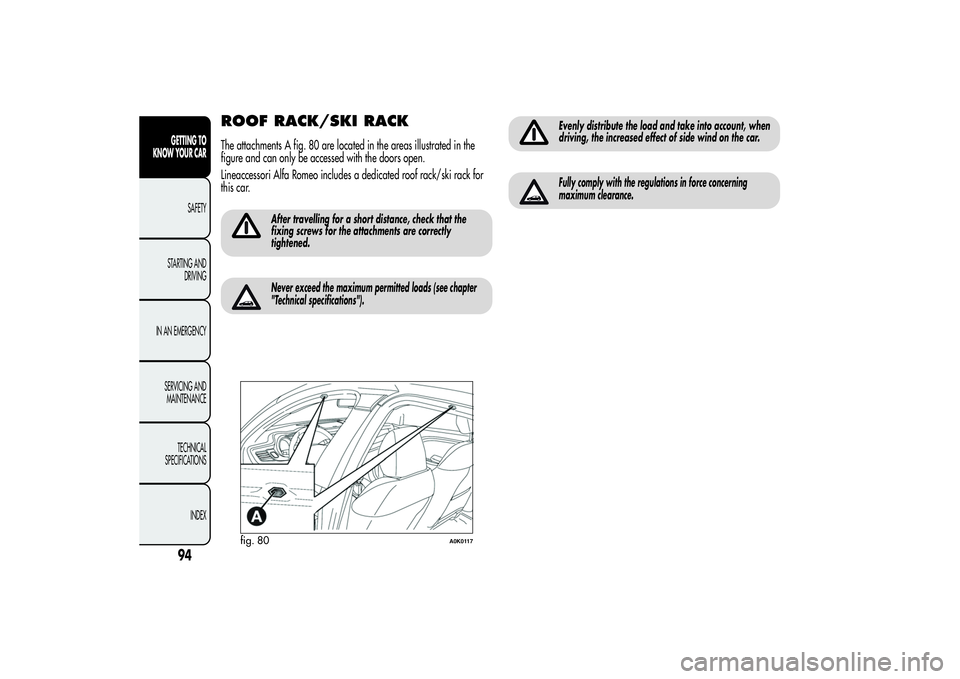
ROOF RACK/SKI RACKThe attachments A fig. 80 are located in the areas illustrated in the
figure and can only be accessed with the doors open.
Lineaccessori Alfa Romeo includes a dedicated roof rack/ski rack for
this car.
After travelling for a short distance, check that the
fixing screws for the attachments are correctly
tightened.Never exceed the maximum permitted loads (see chapter
"Technical specifications").
Evenly distribute the load and take into account, when
driving, the increased effect of side wind on the car.Fully comply with the regulations in force concerning
maximum clearance.
fig. 80
A0K0117
94GETTING TO
KNOW YOUR CAR
SAFETY
STARTING AND
DRIVING
IN AN EMERGENCY
SERVICING AND
MAINTENANCE
TECHNICAL
SPECIFICATIONS
INDEX
Page 99 of 292
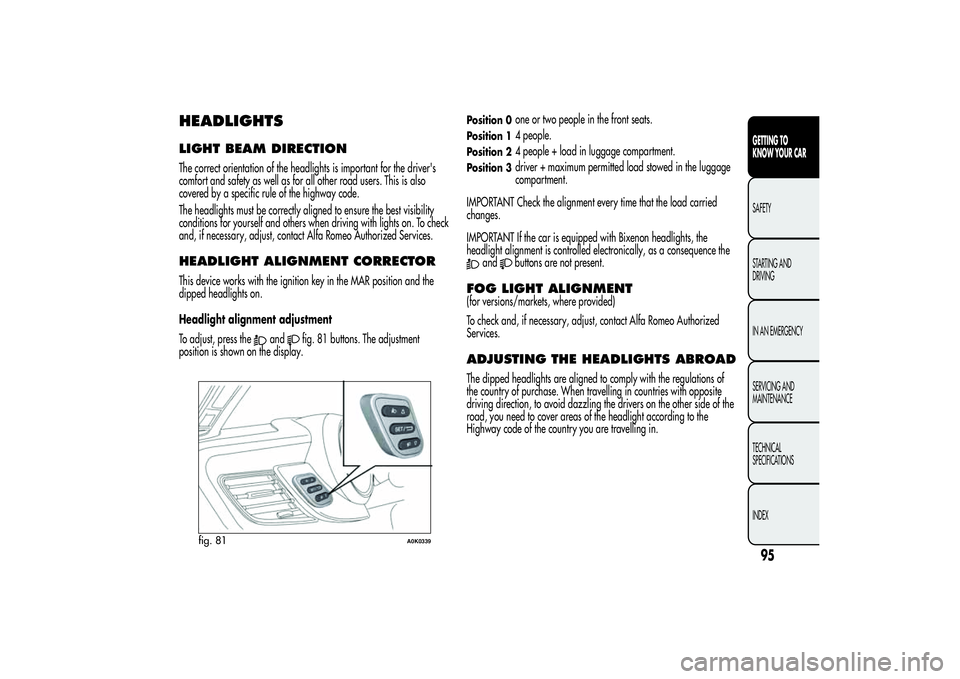
HEADLIGHTSLIGHT BEAM DIRECTIONThe correct orientation of the headlights is important for the driver's
comfort and safety as well as for all other road users. This is also
covered by a specific rule of the highway code.
The headlights must be correctly aligned to ensure the best visibility
conditions for yourself and others when driving with lights on. To check
and, if necessary, adjust, contact Alfa Romeo Authorized Services.HEADLIGHT ALIGNMENT CORRECTORThis device works with the ignition key in the MAR position and the
dipped headlights on.
Headlight alignment adjustment
To adjust, press the
and
fig. 81 buttons. The adjustment
position is shown on the display.
Position 0
one or two people in the front seats.
Position 1
4 people.
Position 2
4 people + load in luggage compartment.
Position 3
driver + maximum permitted load stowed in the luggage
compartment.
IMPORTANT Check the alignment every time that the load carried
changes.
IMPORTANT If the car is equipped with Bixenon headlights, the
headlight alignment is controlled electronically, as a consequence the
and
buttons are not present.
FOG LIGHT ALIGNMENT(for versions/markets, where provided)
To check and, if necessary, adjust, contact Alfa Romeo Authorized
Services.ADJUSTING THE HEADLIGHTS ABROADThe dipped headlights are aligned to comply with the regulations of
the country of purchase. When travelling in countries with opposite
driving direction, to avoid dazzling the drivers on the other side of the
road, you need to cover areas of the headlight according to the
Highway code of the country you are travelling in.
fig. 81
A0K0339
95GETTING TO
KNOW YOUR CARSAFETY
STARTING AND
DRIVING
IN AN EMERGENCY
SERVICING AND
MAINTENANCE
TECHNICAL
SPECIFICATIONS
INDEX
Page 100 of 292
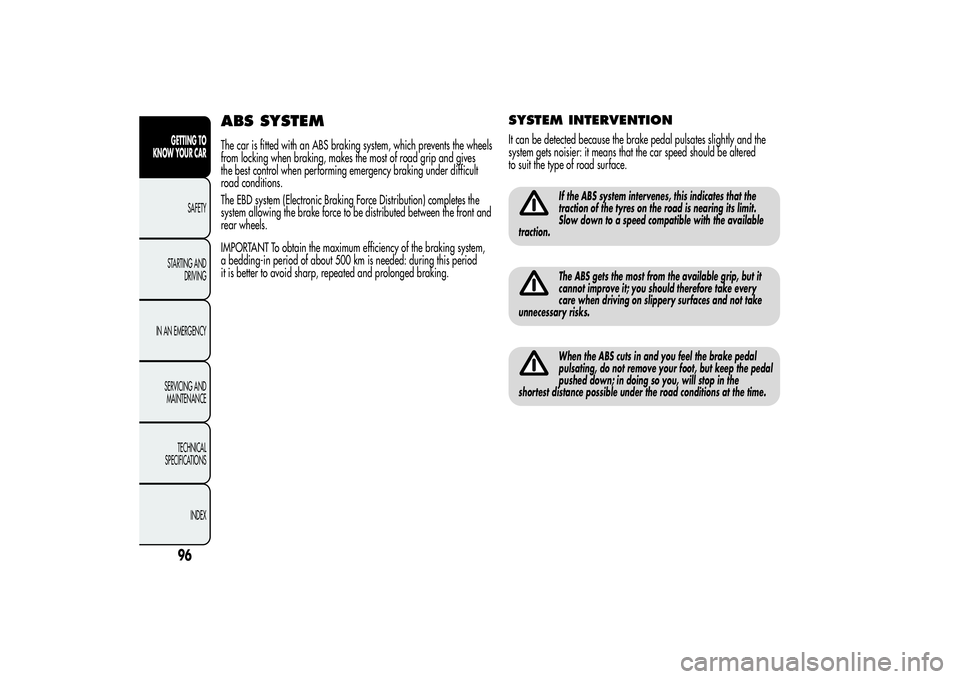
ABS SYSTEMThe car is fitted with an ABS braking system, which prevents the wheels
from locking when braking, makes the most of road grip and gives
the best control when performing emergency braking under difficult
road conditions.
The EBD system (Electronic Braking Force Distribution) completes the
system allowing the brake force to be distributed between the front and
rear wheels.
IMPORTANT To obtain the maximum efficiency of the braking system,
a bedding-in period of about 500 km is needed: during this period
it is better to avoid sharp, repeated and prolonged braking.
SYSTEM INTERVENTIONIt can be detected because the brake pedal pulsates slightly and the
system gets noisier: it means that the car speed should be altered
to suit the type of road surface.
If the ABS system intervenes, this indicates that the
traction of the tyres on the road is nearing its limit.
Slow down to a speed compatible with the available
traction.The ABS gets the most from the available grip, but it
cannot improve it; you should therefore take every
care when driving on slippery surfaces and not take
unnecessary risks.When the ABS cuts in and you feel the brake pedal
pulsating, do not remove your foot, but keep the pedal
pushed down; in doing so you, will stop in the
shortest distance possible under the road conditions at the time.
96GETTING TO
KNOW YOUR CAR
SAFETY
STARTING AND
DRIVING
IN AN EMERGENCY
SERVICING AND
MAINTENANCE
TECHNICAL
SPECIFICATIONS
INDEX